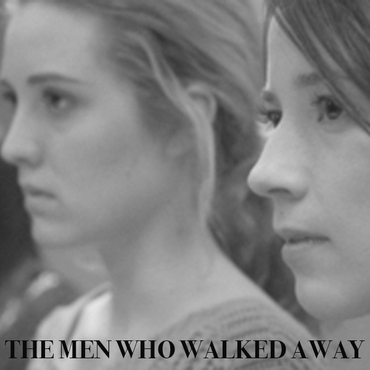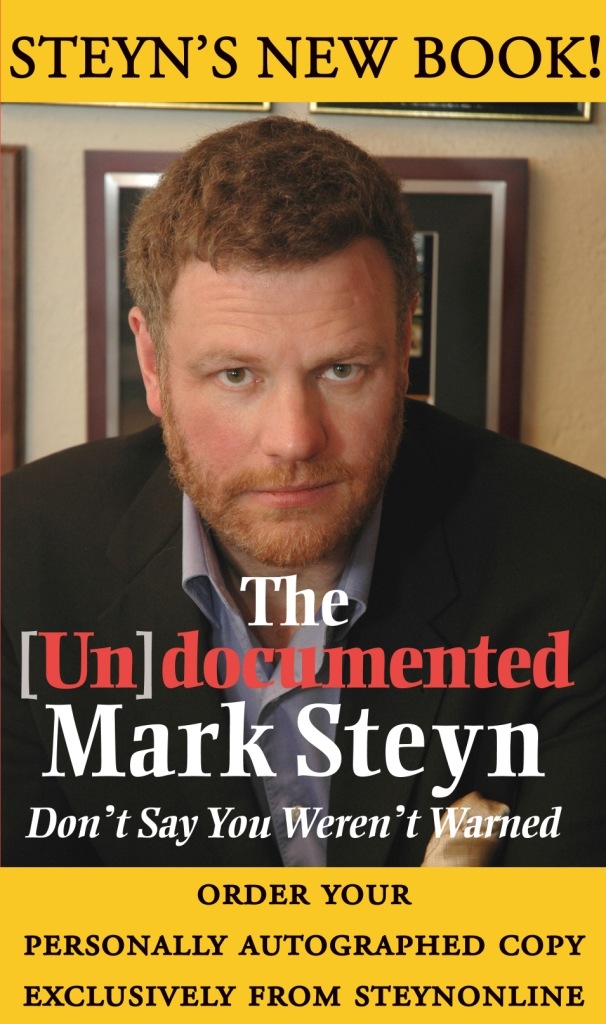Programming note: Join me later this evening for another episode of our nightly audio adventure - and the first of this year's Christmas capers - Mystery in White by Jefferson Farjeon. It airs right here at SteynOnline at 7pm North American Eastern - which is midnight Greenwich Mean Time. On Saturday I'll be back for the latest edition of our weekend music show, Mark Steyn on the Town, which airs on Serenade Radio every Saturday at 5pm Greenwich Mean Time - which is 6pm in Western Europe and 12 midday North American Eastern. You can listen from almost anywhere on the planet by clicking the button at top right here.
~It's only a couple of days since I hinted at the introduction of our "As I wrote twenty years ago" feature. Here is another recurring subject of this new century: We are closer than any society should be to the end of men - which is a big source of the terrible confusion in our schools that has led girls to offer themselves up for bodily mutilation in pursuit of a delusion. In the dismantling of manhood and manliness, no lie is too outrageous. So today, December 6th, marks the thirty-fifth anniversary of the "Montreal Massacre" - a grim day in 1989 when fourteen female students at the École Polytechnique were murdered by a man known to posterity as "Marc Lépine". Much followed from that terrible slaughter, including various useless "gun control" measures - and the formal annual commemorations that, a third-of-a-century on, are attended by as many eminences as Remembrance Day or Dominion Day. The men present in that classroom are now pushing sixty; the women are not. I was far from home that December and was not back in Quebec until Christmas. And so I accepted the official narrative of events - until, that is, a few years later, when I looked into it myself.
At which point I marvelled at how the Canadian state had succeeded in so thoroughly imposing a meaning on the slaughter that is more or less the precise opposite of what actually happened. I've written about it over the years, although my comrades in the Canadian media complain every time I do so, as if any questioning of the official fairy tale cannot be permitted. Here's what I said on the thirteenth anniversary, in The National Post of Canada on December 12th 2002 - twenty-two years ago:
I loathe the annual commemorations of the Montreal Massacre. I especially dislike the way it's become a state occasion, with lowered flags, like Remembrance Day. But, in this case, whatever honour we do the dead, we spend as much time dishonouring the living -- or at least the roughly fifty per cent of Canadians who happen to be male: For women's groups, the Montreal Massacre is an atrocity that taints all men, and for which all men must acknowledge their guilt. Marc Lépine symbolizes the murderous misogyny that lurks within us all.
M Lépine was born Gamil Gharbi, the son of an Algerian Muslim wife-beater, whose brutalized spouse told the court at their divorce hearing that her husband "had a total disdain for women and believed they were intended only to serve men." At eighteen, young Gamil took his mother's maiden name. The Gazette in Montreal mentioned this in its immediate reports of the massacre. The name "Gamil Gharbi" has not sullied its pages in the thirteen years since.
Ah, well, I would bring that up, wouldn't I? Just for the record, I'm not saying that M Lépine is representative of Algerian manhood or Muslim manhood. I'm saying he shouldn't be representative of anything -- least of all, the best efforts of women's groups and the convenient gloss of that pure laine name notwithstanding, Canadian manhood.
This spring, there was an attempted gun massacre at the Appalachian School of Law in West Virginia. But, alas for the Appalachians' M Lépine, there were two gun-totin' students present who were able to pin down the would-be mass murderer until the cops arrived. Allan Rock stepping forward to recite the relevant portions of the gun registry requirements would have been far less effective. Generally speaking, when the psycho shows up and opens fire, your best hope is that there's someone else around with a gun to hand -- a situation Canadian law has now rendered all but impossible.
Extreme cases make bad law, and just because it's a cliché doesn't mean the Liberal Party of Canada can't take it to hitherto undreamt of heights. Our disarmed Dominion will be the first jurisdiction on the planet with a one-billion dollar gun-registry. It was supposed to cost two million, but, as Dr Evil learned in Austin Powers, these days that's just chump change, they'll laugh at you. No self-respecting government plan should cost less than ONE BILLION DOLLARS!!!!! According to police, the gun registry is officially 25 per cent inaccurate. I'd figure that makes it unofficially 40 per cent inaccurate. But last week, while cynical Liberal bigwigs were openly boasting that this record-breaking government fraud would just be another one of those things you hear about for a couple of days that then mysteriously vaporizes somewhere over Shawinigan, the radio call-in shows were full of concerned, earnest, reasonable, moderate Canadians saying that, even if it did cost a billion, it still "sends the right message" on gun control. Which is just as well, as it'll still be sending the right message when it's up to two billion...The gun registry is symbolic not of Canada's predisposition to mass murder, but Canada's predisposition to mass suicide.
But the gun-registry boondoggle is just big-government business as usual. In a certain sense, the men present that day in Montreal were more profoundly disarmed. From my book After America:
To return to Gloria Steinem, when might a fish need a bicycle? The women of Montreal's École Polytechnique could have used one when Marc Lépine walked in with a gun and told all the men to leave the room. They meekly did as ordered. He then shot all the women.
Which is the more disturbing glimpse of Canadian manhood? The guy who shoots the women? Or his fellow men who abandon them to be shot? For me, the latter has always been the darkest element of the story. From my column in Maclean's, January 9th 2006:
Every December 6th, our own unmanned Dominion lowers its flags to half-mast and tries to saddle Canadian manhood in general with the blame for the Montreal massacre -- the fourteen women murdered by Marc Lépine, born Gamil Gharbi, the son of an Algerian Muslim wife-beater, though you wouldn't know that from the press coverage. Yet the defining image of contemporary Canadian maleness is not M Lépine/Gharbi but the professors and the men in that classroom, who, ordered to leave by the lone gunman, obediently did so, and abandoned their female classmates to their fate -- an act of abdication that would have been unthinkable in almost any other culture throughout human history. The "men" stood outside in the corridor and, even as they heard the first shots, they did nothing. And, when it was over and Gharbi walked out of the room and past them, they still did nothing. Whatever its other defects, Canadian manhood does not suffer from an excess of testosterone.
Your average Western feminist lobby group doesn't see it that way, naturally. "The feminism I think of is the one that embodies inclusivity, multiculturalism and the ability to change the world through the humanity that women do bring," says Stephanie Davis, executive director of Atlanta's Women's Foundation. "If there were women in power in representative numbers -- 52 per cent -- I think that the World Trade Center would still be standing."
That's a familiar line. If only your average Security Council meeting looked like a college graduating class, or that room at the École Polytechnique after the men had departed, there would be peace on earth.
I don't think so. Look at the current rape statistics under one of the most thoroughly feminised regimes on earth - the Government of Sweden. More from After America:
To those who succeeded in imposing the official narrative, Marc Lépine embodies the murderous misogynist rage that is inherent in all men, and which all must acknowledge.
For a smaller number of us, the story has quite the opposite meaning: whatever M Lépine embodies, it's certainly not (if you'll forgive the expression) Canadian manhood.
In 2009, the director Denis Villeneuve made a film of the story - Polytechnique. "I wanted to absolve the men," he said. "People were really tough on them. But they were 20 years old... It was as if an alien had landed."
But it's always as if an alien had landed. When another Canadian director, James Cameron, filmed Titanic, what most titillated him were the alleged betrayals of convention. It's supposed to be "women and children first", but he was obsessed with toffs cutting in line, cowardly men elbowing the womenfolk out of the way and scrambling for the lifeboats, etc. In fact, all the historical evidence is that the evacuation was very orderly. In real life, First Officer William Murdoch threw deckchairs to passengers drowning in the water to give them something to cling to, and then he went down with the ship – the dull, decent thing, all very British, with no fuss. In Cameron's movie, Murdoch takes a bribe and murders a third-class passenger. (The director subsequently apologized to the First Officer's home town in Scotland and offered £5,000 toward a memorial. Gee, thanks.) Mr Cameron notwithstanding, the male passengers gave their lives for the women, and would never have considered doing otherwise. "An alien landed" on the deck of a luxury liner – and men had barely an hour to kiss their wives goodbye, and watch them clamber into the lifeboats to sail off without them. The social norm of "women and children first" held up under pressure.
Today, in what Harvey Mansfield calls our "gender-neutral society", there are no social norms. Eight decades after the Titanic, a German-built ferry en route from Estonia to Sweden sank in the Baltic Sea. Of the 1,051 passengers, only 139 lived to tell the tale. But the distribution of the survivors was very different from that of the Titanic. Women and children first? No female under 15 or over 65 made it. Only five per cent of all women passengers lived. The bulk of the survivors were young men. Forty-three per cent of men aged 20-24 made it.
"There is no law that says women and children first," Roger Kohen of the International Maritime Organization told Time magazine. "That is something from the age of chivalry."
If, by "the age of chivalry", you mean the early 20th century.
As I said, no two maritime disasters are the same. But it's not unfair to conclude that, had the men of the Titanic been on the Estonia, the age and sex distribution of the survivors would have been very different. Nor was there a social norm at the École Polytechnique. So the men walked away, and the women died.
Whenever I've written about these issues, I get a lot of e-mails from guys scoffing, "Oh, right, Steyn. Like you'd be taking a bullet. You'd be pissing your little girlie panties," etc. Well, maybe I would. But as the Toronto blogger Kathy Shaidle put it:
When we say 'we don't know what we'd do under the same circumstances', we make cowardice the default position.
I prefer the word passivity – a terrible, corrosive passivity. Even if I'm wetting my panties, it's better to have the social norm of the Titanic and fail to live up to it than to have the social norm of the Polytechnique and sink with it.
~The above includes material from Mark's book After America, and from his review of the film Polytechnique, which can be read in full here. If you disagree with Steyn and you're a member of The Mark Steyn Club, then feel free to have at him in the comments.






















